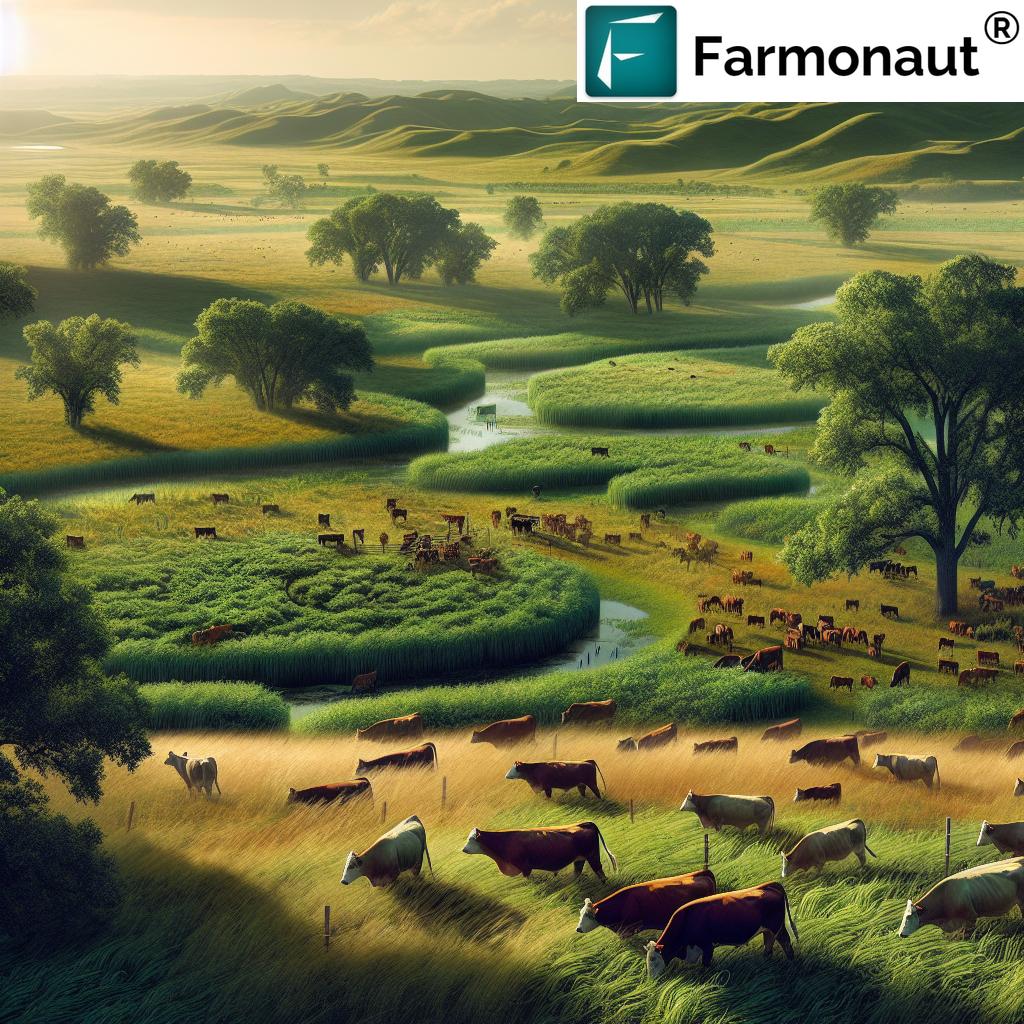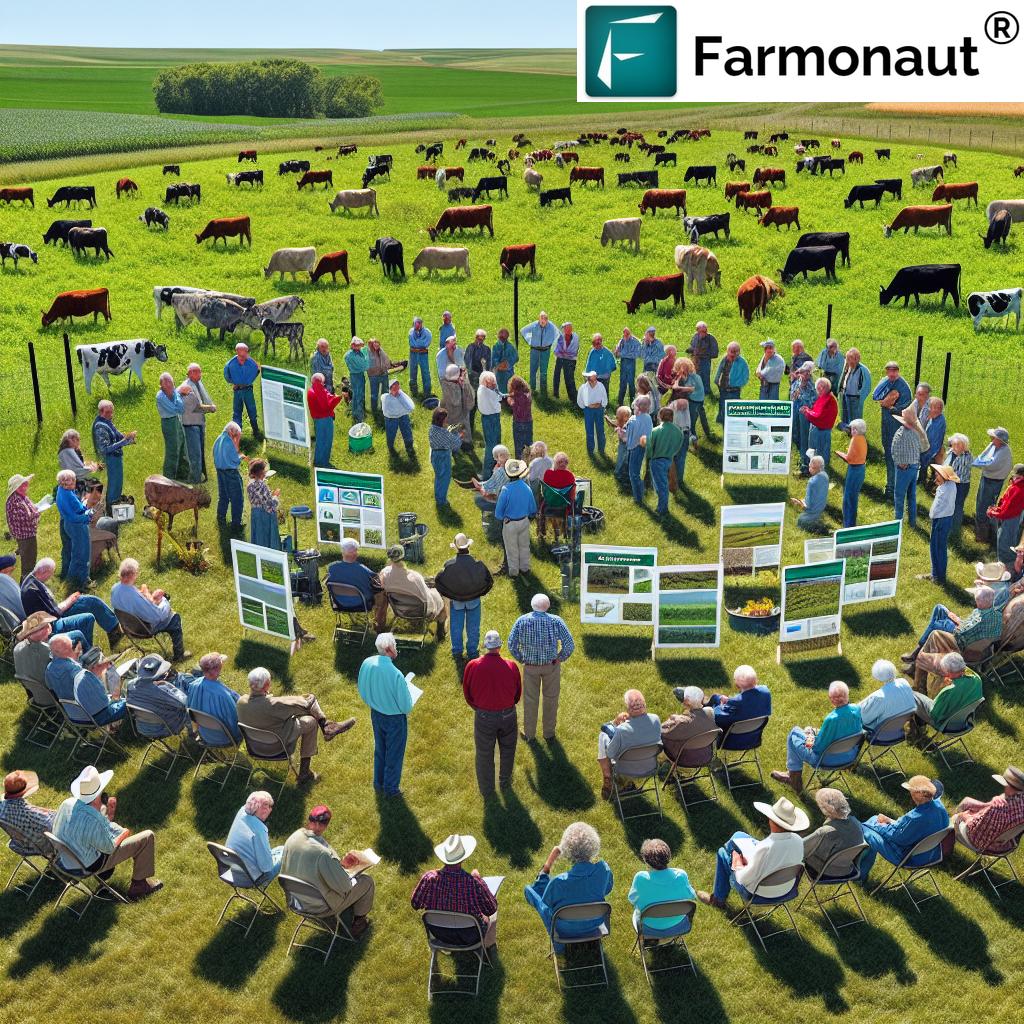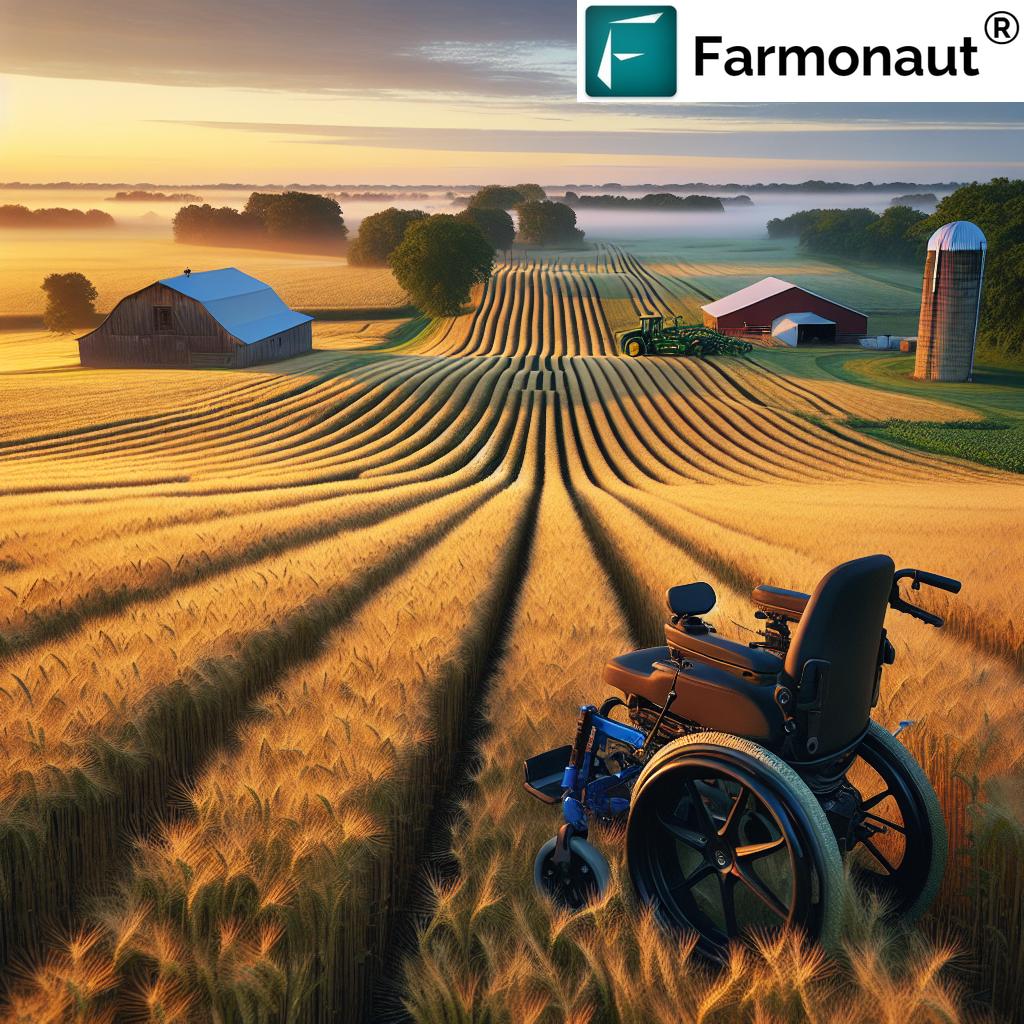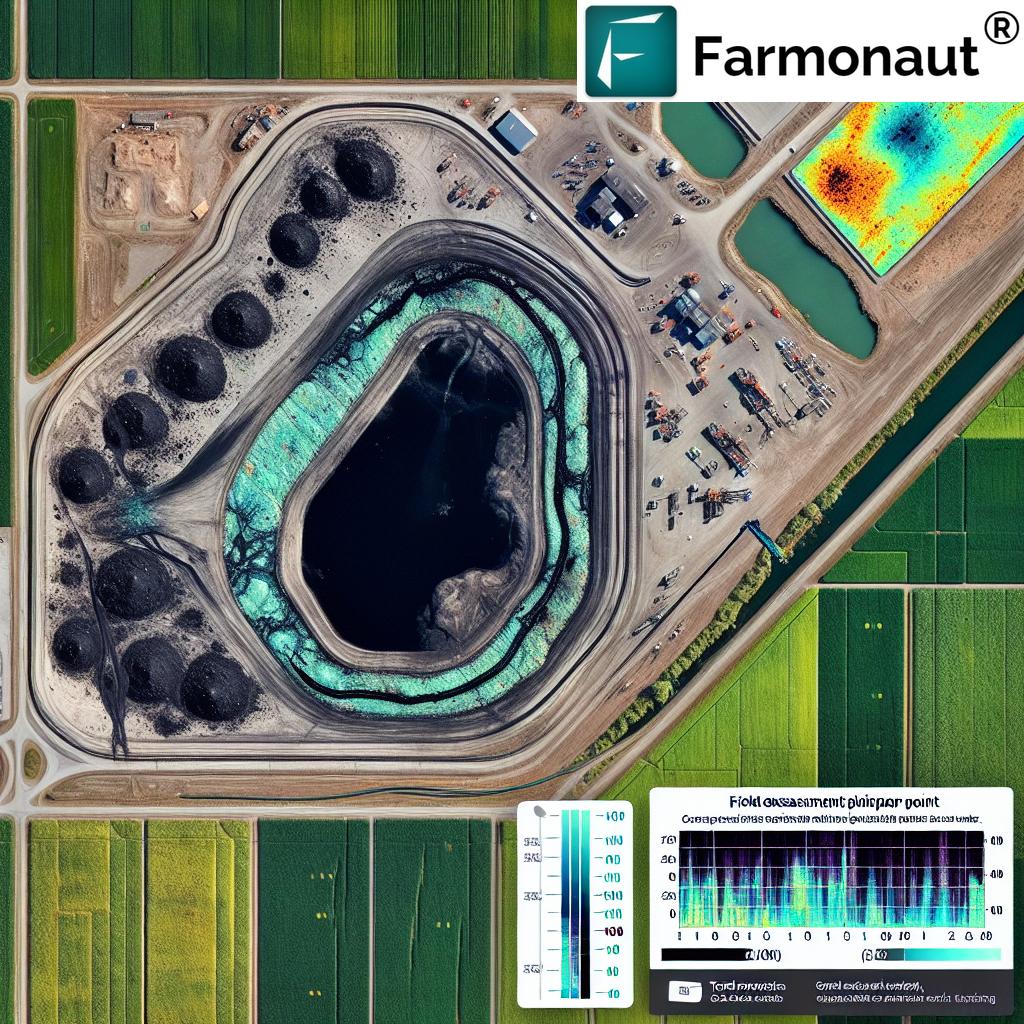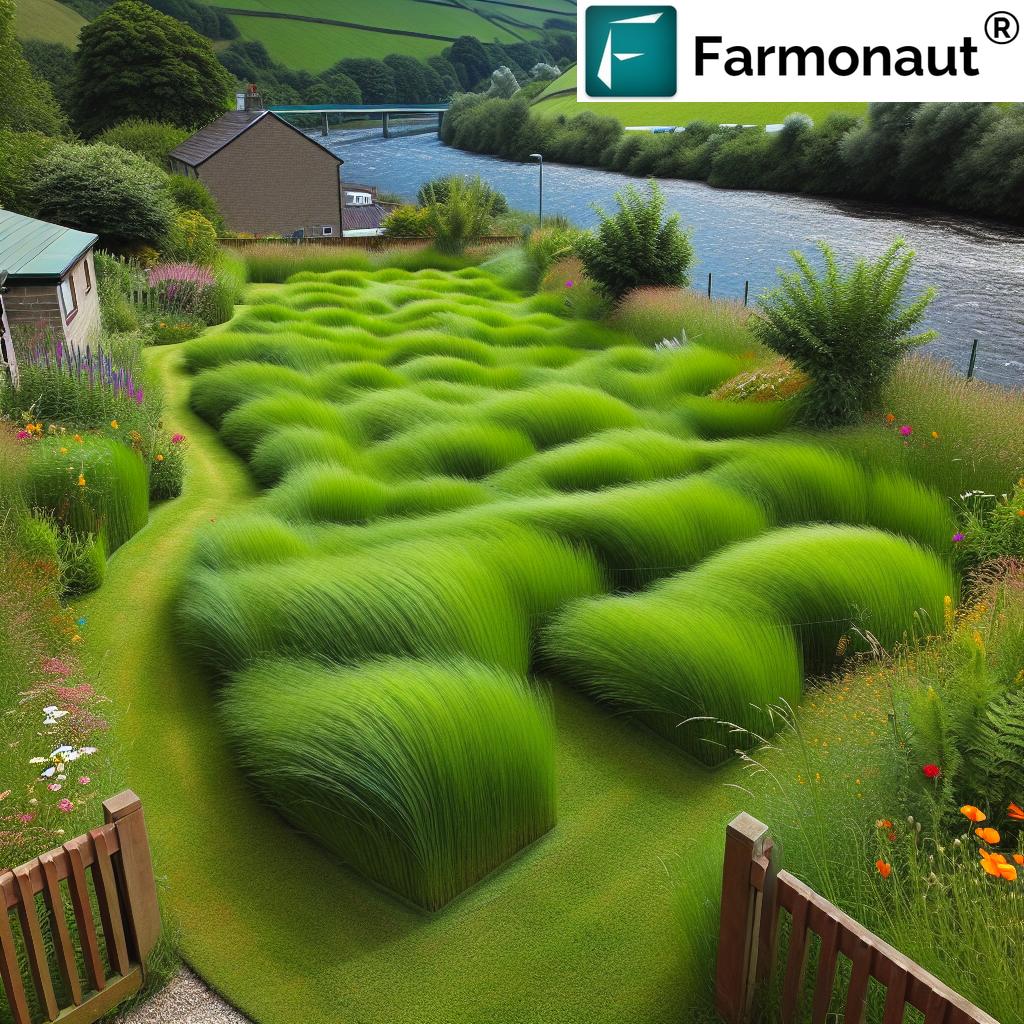Pasture Management Iowa: 5 Grazing Tips for Producers
“Iowa pastures can support up to 2.5 animal units per acre with proper rotational grazing techniques.”
Table of Contents
- Introduction: The Role of Pasture in Iowa Agriculture
- The Value of Pasture Walks for Livestock Producers
- Tip 1: Embrace Rotational Grazing for Sustainable Pasture Management Iowa
- Tip 2: Conduct Thorough Pasture Health Assessment and Soil Testing
- Tip 3: Optimize Stocking Density for Improved Grazing Practices Northwest Iowa
- Tip 4: Prioritize Managing Mixed Grass Pastures for Maximum Productivity
- Tip 5: Implement Agricultural Conservation Practices for Soil and Water Conservation in Iowa
- Outdoor Learning for Farm Operators: Why Hands-On Matters
- Leveraging Farmonaut Technology for Modern Pasture Management
- Comparative Table: Key Grazing Tips & Estimated Outcomes
- FAQ: Pasture Management Iowa
- Event Details: Upcoming Pasture Walk in Northwest Iowa
- Farmonaut Solutions & App Links
- Farmonaut Subscription Options
- Conclusion: Paving the Way for Sustainable Pasture Management in Iowa
Introduction: The Role of Pasture in Iowa Agriculture
Ames, Iowa – Pasture is an integral part of Iowa’s diverse agricultural landscape. Serving as the backbone for livestock operations, pastures provide not only feed but also environmental and economic stability for countless producers across Lyon, Osceola, Sioux, O’Brien, and other county lines. Recognizing this, Iowa State University (ISU) Extension and Outreach continues to support farm operators with practical, research-backed resources and outdoor learning opportunities.
The tremendous richness of pasture management Iowa systems means we must stay diligent in our pursuit of best grazing practices, continually adapting to current challenges— climatic shifts, evolving soil and water conservation priorities, and market demands among them. Producers in our state rely on both tradition and cutting-edge agricultural technologies to maintain their pastures, ensure animal well-being, and enhance whole-farm productivity.
In this comprehensive guide, we’ll explore real-world examples and strategies to excel at grazing practices Northwest Iowa, improve your pasture health assessment, and implement hands-on conservation initiatives. We’ll also highlight opportunities such as the annual pasture walks for livestock producers staged by ISU Extension, and show how you can leverage modern technology (like Farmonaut) to monitor and optimize every acre.
The Value of Pasture Walks for Livestock Producers
Each season, pasture walks for livestock producers offer us an invaluable opportunity to explore real-world examples of pasture management in Iowa. Guided by ISU Extension specialists and local experts, these events combine classroom theory and hands-on practice—allowing farmers from Sioux, Lyon, Osceola, and O’Brien counties to assess and improve their own grazing and forage management plans.
Beth Doran, ISU Extension and Outreach beef specialist, reminds us, “Successful grazing involves careful planning and timely management—it’s more than just turning the cows out.” These learning experiences foster a robust exchange of ideas and innovations, giving operators an up-close look at productive systems like the Boersma family’s 30-head stocker cattle operation in Hospers.
By participating in such pasture tours, we not only improve our technical know-how but also strengthen our ties to the larger Iowa agricultural community.
Tip 1: Embrace Rotational Grazing for Sustainable Pasture Management Iowa
Rotational grazing stands out as the most effective technique for modern pasture management Iowa and is widely recommended during ISU Extension pasture walks. This approach involves dividing larger fields into smaller paddocks and rotating livestock between them, allowing sections to rest and recover.
Practical Implementation Steps
- Divide your acres into 4–8 paddocks using portable or permanent fencing.
- Base your rotation schedule on grass growth stages and livestock needs—usually 3–7 days grazing per paddock.
- Ensure clean water and mineral access in every pasture section.
- Monitor forage height, and move animals before overgrazing occurs (typically when sward declines to 3–4 inches for cool-season mixed grasses).
- Allow each paddock time to recover—approximately 21-30 days, depending on weather and grass type.
Key Benefits
- Improved pasture health assessment—roots strengthen and organic matter increases.
- Reduced soil compaction and erosion, aligning with soil and water conservation in Iowa goals.
- Higher forage yields and productivity.
- Enhanced animal performance and well-being.
A well-managed rotational system can support more head of cattle—especially stocker and cow-calf pairs—per acre than continuous grazing. This is why learning proper rotation strategies at pasture walks for livestock producers is invaluable for operators across Northwest Iowa.
To ensure the best results, always consider integrating new technologies. For instance, Farmonaut’s Large Scale Farm Management Platform lets users draw digital paddocks, monitor regrowth using near real-time satellite data, and plan rotations more effectively. This can save time and boost outcomes without extensive manual scouting.
“Over 60% of Northwest Iowa producers use hands-on pasture walks to improve grazing management skills annually.”
Tip 2: Conduct Thorough Pasture Health Assessment and Soil Testing
Next, pasture health assessment is essential, especially when resources and productivity gains are at stake. ISU Extension specialists urge us to evaluate sward density, plant diversity, bare soil, and signs of overgrazing as routine management tasks.
Practical Steps
- Perform regular pasture walks—walk a “W” pattern through fields, taking note of plant health and ground cover.
- Assess organic matter and soil fertility via lab tests for pH, phosphorus, potassium, and micronutrients at minimum every three years.
- Record species composition, weed prevalence, and the proportion of mixed grasses versus legumes through visual scouting and sample analyses.
Key Techniques & Resources
- Use visual scoring grids (available through ISU Extension)—rate coverage, color, and density.
- Engage with Natural Resources Conservation Service (NRCS) guides for standardized protocols.
- Farmonaut’s Carbon Footprinting Tool provides satellite-based insight into plant vigor, NDVI, and resource utilization, ensuring precise pasture management Iowa decisions.
These efforts not only enhance productivity but align with agricultural conservation practices—maintaining healthy soils, minimizing erosion risk, and ensuring nutrients are available for optimal forage growth.
Tip 3: Optimize Stocking Density for Improved Grazing Practices Northwest Iowa
Correct stocking rates are critical for sustained productivity. Overgrazing leads to lower forage quality, bare patches, weed encroachment, and animal health issues. Underutilization, on the other hand, reduces overall system efficiency.
How To Calculate Stocking Density
- Work with ISU Extension or NRCS staff to estimate annual dry matter yields (e.g., 3 tons/acre for high-quality mixed grass pastures in typical Sioux County soils).
- Base animal units on weight (1,000 lbs as one unit). For 30 stocker cattle at 600 lbs each, that’s roughly 18 animal units.
- Match the allowed animal unit months (AUMs) to your available acreage. Most county pasture walkthroughs will share local benchmarks (Iowa often sees sustainable rates of 1.5–2.5 units/acre with rotation).
Stocker Cattle Grazing Tips
- Adjust densities as the season and pasture growth change.
- Remember that grazing practices Northwest Iowa must factor in both cattle needs and drought recovery periods, especially for cool-season grasses in O’Brien, Osceola, and Lyon County.
- Leverage Farmonaut’s Fleet Management Solutions to effectively monitor and plan livestock movement, especially if you manage large herds or need real-time logistics data.
Optimal stocking improves both pasture health and animal productivity—key indicators every responsible operator should track.
Tip 4: Prioritize Managing Mixed Grass Pastures for Maximum Productivity
Iowa’s mixed grass pastures—combining cool and warm-season species—offer flexibility for operators seeking consistent forage throughout the grazing season. Correct mixture and maintenance strategies ensure that health and productivity are optimized.
Practical Guidelines
- Balance cool-season grasses (like brome, orchardgrass) with legumes (red clover, alfalfa) for soil nitrogen, palatability, and drought tolerance.
- Overseed to fill gaps post-grazing or after a prescribed burn—especially in larger paddocks over 10 acres.
- Regularly scout and manage invasive weeds or woody encroachment after major weather events.
- Fertilize based on periodic soil test outcomes for N-P-K and micronutrient maintenance.
- Rest and rotate pastures according to peak regrowth periods—midsummer for warm-season and late spring/fall for cool-season species.
Managing Mixed Grass Pastures with Technology
- Farmonaut’s advisory platform supports operators with real-time satellite imagery-based scouting and AI-generated recommendations (Jeevn AI Advisory), so you optimize grass balance, respond to stress factors, and track overall productivity with ease.
By understanding, supporting, and adapting our mixed grass stands, we can provide healthy, high-quality feed all year—critical for livestock health and producers’ bottom line statewide.
Tip 5: Implement Agricultural Conservation Practices for Soil and Water Conservation in Iowa
Integrating agricultural conservation practices alongside smart grazing is necessary to ensure resilient, productive pasture systems in Iowa’s volatile climate. These measures go beyond meeting compliance; they directly protect profitability, sustainability, and community reputation.
Strategies & Practical Steps
- Install buffer strips and grassed waterways on sloping fields or near waterways—reducing runoff and soil loss.
- Apply rotational haying to occasionally rest pastures from grazing, combat compaction, and diversify flora.
- Utilize rotational water placement—frequent movement of portable waterers limits congregation and compaction in one area.
- Monitor and repair fencing and critical infrastructure (like corrals and lanes) to minimize disturbance and erosion risk.
- Adopt Farmonaut’s Carbon Footprinting Tool to track and reduce the environmental impact of your operation, aligning with both state and federal conservation priorities.
Working with Partners
Collaborate with your county Soil and Water Conservation Districts, the USDA Natural Resources Conservation Service (NRCS), and ISU Extension for technical assistance and possible cost-share programs for conservation projects.
By embedding conservation strategies into our daily management, we affirm our collective commitment to the long-term health of Iowa’s agriculture.
Outdoor Learning for Farm Operators: Why Hands-On Matters
Real action happens in the field. Outdoor learning for farm operators provides us with geometric, tactile understanding which classroom presentations can’t replicate. Pasture walks for livestock producers foster an exchange of ideas, camaraderie, and a network of support critical to navigating modern farming challenges.
Benefits of Outdoor, Hands-On Training
- See “on-the-ground” examples of successful grazing practices northwest Iowa.
- Compare solutions, fence types, water systems, and pasture mixes—as implemented by neighbors and leading Iowa operators.
- Assess forage by sight, smell, and feel with ISU Extension specialists guiding discussion.
- Discuss real-time scenarios—how to pivot under drought stress, plan for herd expansion, or respond to weed outbreaks.
- Connect with service providers and local resources for infrastructure upgrades, conservation cost-shares, or ongoing education.
In short: We learn most when we walk the ground.
Comparative Table: Key Grazing Tips & Estimated Outcomes
| Grazing Tip | Practical Implementation Steps | Estimated Improvement in Pasture Health (%) | Potential Increase in Productivity (lbs/acre) | Suggested Learning Resources |
|---|---|---|---|---|
| Rotational Grazing | Divide pastures into paddocks, implement grazing/rest periods, monitor forage height, rotate accordingly | 20–25% | 400–500 | ISU Extension guides, Farmonaut Farm Management App |
| Pasture Health Assessment & Soil Testing | Visual scoring, W-pattern pasture walks, regular soil fertility tests, plant composition evaluation | 15–20% | 250–400 | ISU Extension, NRCS, Farmonaut Carbon Tool |
| Optimizing Stocking Density | Calculate animal units, match to regrowth, track seasonal yield adjustments, adjust as conditions change | 10–15% | 200–350 | ISU Extension calculators, Farmonaut Fleet Tools |
| Managing Mixed Grass Pastures | Balance grass types, fertilize per test, overseed as needed, rest according to species, monitor invasives | 10–15% | 250–300 | ISU Pasture Mixes Guide, Farmonaut AI Advisory |
| Agricultural Conservation Practices | Buffer strips, rotational water placement, infrastructure repair, hay rest periods, erosion control | 15–20% | 300–400 | NRCS, SWCD, Farmonaut Carbon Tool |
Leveraging Farmonaut Technology for Modern Pasture Management Iowa
Satellite, AI, and digital data tools are reshaping pasture management in Iowa. Farmonaut stands at the intersection of cutting-edge technology and hands-on farm practicality, making precision agriculture accessible to all producers.
Key Features & Use Cases
- Satellite Monitoring: Visualize pasture health, soil moisture, vegetation vigor (NDVI), and water stress without ever leaving the office or while walking your field.
- AI-Based Farm Advisory: Farmonaut’s Jeevn AI delivers field-specific recommendations—fertility, irrigation, grazing turn-out dates—by analyzing multi-year satellite trends and local weather patterns.
- Blockchain Traceability: Producers looking for full supply chain transparency can adopt Farmonaut’s Product Traceability Solution to verify the origin of livestock and forage, enhancing trust with end consumers or buyers in regulated sectors (e.g., organic beef).
- Fleet & Resource Management: Agribusinesses can manage equipment and fleet for haying, fertilizer delivery, or animal transport via Farmonaut’s Fleet Tools, reducing costs and optimizing routes.
- Environmental Compliance: Monitor, track, and minimize carbon footprint with Farmonaut’s Carbon Footprinting Solutions, vital for Iowa producers facing watershed or emissions regulations.
- Crop Loans and Insurance: Utilize Farmonaut’s satellite-based verification for crop loan & insurance, facilitating access to financial products and mitigating insurance fraud risks.
All features are accessible via secure web and mobile apps—meaning you can monitor your operation’s status from the barn, pasture, or at a county event.
Developers or agri-businesses wanting to integrate these capabilities in their custom software solutions can use Farmonaut’s robust Satellite & Weather API with complete documentation found here.
Pasture Health Assessment in Action
By leveraging digital NDVI scouting maps through Farmonaut, producers can quickly identify underperforming zones or waterlogged patches, so corrective measures (like more rest, overseeding, or drainage improvements) can be taken.
FAQ: Pasture Management Iowa
What is the best month to assess pasture health in Iowa?
Late spring to early summer (May–June) provides a clear picture of cool-season grass vigor, emergence of legumes, and weed pressure. Fall assessments help in planning re-seeding or fertility.
How often should I rotate my cattle in a rotational grazing system?
This depends on forage growth rate (season, species, soil moisture), but generally every 3–7 days per paddock. Move animals before grass dips below recommended height (3–4 inches).
How do I determine the right stocking density for my mixed grass pasture?
Start with extension recommendations for your county, calculate available dry matter, and adjust for livestock weight/number. The right density ensures ample regrowth and animal gains—working with ISU Extension and using digital tools like Farmonaut greatly simplifies the process.
Are there financial programs or incentives for implementing conservation practices?
Yes, through USDA NRCS EQIP, county Soil and Water Conservation Districts, and state programs you can often secure cost-share for fencing, buffer strips, and water improvements. ISU Extension staff are excellent first contacts for details and sign-up help.
Can digital farm management apps really make a difference in everyday pasture operations?
Absolutely. Farmonaut’s suite enables real-time, actionable decision-making—boosting efficiency, productivity, and even compliance reporting—straight from your smartphone, tablet, or computer.
Event Details: Upcoming Pasture Walk in Northwest Iowa
Mark your calendar for this year’s highlight pasture walk in Northwest Iowa:
- Date: July 10
- Location: Justin Boersma farm, 4347 390th St., Hospers, Sioux County
- Time: 5:30 p.m. (light supper), speakers and pasture tour from 6 to 8:45 p.m.
Topics: How to get started and manage grazing, with first-hand look at grazing 30 head of stocker cattle on 16 acres of mixed grasses. Attendees will benefit from the presence of ISU Extension and Outreach, USDA Natural Resources Conservation Service, and several area Soil and Water Conservation Districts.
There is no charge, thanks to support from Lyon, O’Brien, Osceola, and Sioux counties. Directions and registration:
- Register by July 2 by calling ISU Extension and Outreach Sioux County at 712-737-4230 or emailing Beth Doran.
- Dress for outdoor walking, and bring a lawn chair for comfort.
Don’t miss this hands-on learning experience that directly improves whole-farm management for years to come.
Farmonaut Solutions & App Links
-
Web App – Access satellite monitoring, digital field planning, and advisory tools on your computer.

-
Android App

-
iOS App

- API Portal – For agribusinesses and developers who want direct satellite & weather data integration.
- API Developer Docs – Complete integration documentation.
- Product Traceability Solution – Secure, blockchain-based tracing for agriculture supply chain transparency.
- Crop Loan & Insurance Verification – Smooth, trustworthy financing using satellite data.
- Carbon Footprinting Tool – Monitor and minimize your operation’s environmental impact.
- Fleet & Resource Management – Efficiently track vehicles and farm equipment for large or multi-site operations.
Farmonaut Subscription Options
Access Farmonaut’s powerful satellite-based monitoring, advisory, fleet, carbon tracking, and traceability solutions with flexible, scalable subscription plans for all farm sizes and business types—available for individual producers, cooperatives and agribusinesses.
Conclusion: Paving the Way for Sustainable Pasture Management in Iowa
Our Iowa pastures are more than feed—they are the roots of a sustainable agricultural landscape and the backbone of thriving rural economies. Excellence in pasture management Iowa means combining proven grazing practices Northwest Iowa, hands-on outdoor learning, and digital technology—together.
Each step—from embracing rotational grazing to adopting satellite insight via Farmonaut—empowers us to steward our resources, ensure animal health, and stay competitive and resilient in a changing world. Attend a pasture walk, exchange ideas, try new methods, and invest in continuous improvement for your operation.
Ready to transform your pasture management in Iowa? Make use of ISU Extension and Outreach events, connect with your Soil and Water Conservation District for support, and bring digital precision to the farmgate with Farmonaut.
Let’s walk our pastures—and the future—together.


